Trying to decide between the 7mm-08 Remington and 270 Winchester cartridges? Here’s what you need to know about them.
I think most hunters would agree the 270 Winchester and 7mm-08 Remington are both excellent cartridges for certain situations. While there is definitely some overlap in their capabilities, there are some major differences between the 7mm-08 vs 270 Winchester cartridges you should be aware of though.
Both are popular and effective centerfire rifle cartridges with dedicated fan bases, but important details about their performance unfortunately get overlooked or simply lost in the shuffle. With that in mind, it’s easy to see how many people get confused about the strengths and weaknesses of the 270 Winchester and 7mm-08 Remington, particularly when discussing which cartridge is best for hunting particular animals under specific conditions.
In fact, despite their big differences in outward appearance, the two cartridges are almost shockingly similar in performance. Even so, there’s some important differences to keep in mind and each is better suited for different hunting tasks.
In this article, I’m going to investigate the 7mm-08 vs 270 debate in detail and provide some insight into which cartridge is better suited for common hunting situations so you can make an informed decision on which one will work best for your individual needs as a hunter or shooter.
Before we get started, I have an administrative note for you.
Some of the links below are affiliate links. This means I will earn a small commission (at no extra cost to you) if you make a purchase. This helps support the blog and allows me to continue to create free content that’s useful to hunters like yourself. Thanks for your support.
Additionally, I recorded an entire podcast episode on this exact subject. If you’d rather listen than read, click the appropriate link below to listen to this episode on your preferred podcasting service.
7mm-08 vs 270 Podcast
Apple | Google | iHeart | Spotify | Stitcher
History Of The 270 Winchester and 7mm-08 Remington
The story of the .270 Winchester and the 7mm-08 Remington both start with the .30-06 Springfield.
The United States Army started looking for a new infantry service rifle and cartridge after receiving a deadly demonstration of the capabilities of the revolutionary new Mauser rifle and 7mm Mauser cartridge in the hands of Spanish troops in Cuba during 1898.
They eventually selected the bolt action 1903 Springfield rifle chambered in the new .30-06 Springfield cartridge.
The new .30-06 Springfield was dimensionally extremely similar to the 7x57mm Mauser and it’s highly likely that the designers of the 30-06 based their cartridge design heavily on the revolutionary 7mm Mauser cartridge.
Some have even gone so far as to say that the 7mm Mauser is the parent to the less well known 30-03 Springfield as well as the legendary 30-06 Springfield.
Anyway, initial loadings for that cartridge used smokeless powder to fire a 150 grain spitzer bullet at 2,700 feet per second (2,428 ft-lbs of energy). Believe it or not, that was a massive leap forward in performance compared to other popular American cartridges used during that era like the .45-70 Government.
Not only was the 30-06 a big hit with the military, but it was an almost instant success in the civilian market as well.
As is often the case with any well designed centerfire rifle cartridge (like the 7mm Mauser or the .30-30 Winchester for instance), wildcatters quickly started modifying the .30-06 Springfield to accomplish a variety of different tasks.
Some designers opted to neck down the .30-06 case to use smaller diameter bullets (like the .25-06 Remington and 280 Remington). This is what the folks at Winchester did when they modified the case to use smaller .277″ instead of .308″ bullets.
The result was the .270 Winchester cartridge, which they released in 1925 with the Winchester Model 54 rifle.
The original .270 Winchester offering shot a 130 grain bullet at a velocity of 3,140 feet per second (2,846 ft-lbs of energy). This was an incredibly high velocity for the 1920s and was a tremendous speed improvement over the .30-06 Springfield, which was itself considered a very high velocity cartridge at the time.
If you’d like to learn how the .270 Winchester compares to its parent case in the .30-06, read the article below:
270 vs 30-06 Debate Settled Once And For All
Subsequent factory loadings for the cartridge have dropped the typical velocity with 130gr bullets down to about 3,060fps. This is still a pretty high velocity loading, even today.
American hunters appreciated the flat shooting characteristics of the round and the fact that it was so effective on thin skinned game. The cartridge gradually became more and more popular, which was helped by Jack O’Connor and his famous affinity for the cartridge that he expressed in countless Outdoor Life articles over the years.
While O’Connor did indeed love the .270 Winchester and used it extensively on hunts all over the world, it was far from the only cartridge he used. Indeed, the .270 Winchester was also a good enough cartridge and filled a big enough niche that it probably would have been successful even without any help from Jack O’Connor.
The .270 Winchester is a bit of an oddity when it comes to bullet diameter though. Unlike all the other popular 7mm cartridges like the 7mm Mauser, 7mm Remington Magnum, the .280 Remington, and the 28 Nosler that use .284″ bullets, the .270 Winchester uses slightly smaller diameter .277″ bullets.
It’s unclear exactly why designers at Winchester decided to go with .277″ instead of .284″ bullets with the .270 Winchester. One theory is they selected that particular bullet size based on the obscure 6.8x57mm Chinese Mauser cartridge.
It’s also possible the folks at Winchester wanted to create a distinctly American bullet size and avoid the 6.5mm and 7mm bullets popular in Europe by building a new brand new bullet diameter 10% smaller than the one used in the .30-06 (.9 multiplied by .308 is .277).
Regardless of their exact reasons, the design team at Winchester went with a .277″ bullet diameter and the rest is history. Interestingly enough, while the .270 Winchester turned out to be a smashing commercial success for the company, .277″ bullets haven’t really caught on themselves.
The 270 Winchester Short Magnum (270 WSM) and the .270 Weatherby Magnum along with the newer 6.8 Remington SPC, 27 Nosler, and 6.8 Western are the only other mass produced cartridges that utilize bullets of that size.
Even so, the 270 Winchester remains an incredibly popular and effective big game hunting cartridge all over the world.
Now let’s talk about the 7mm-08 Remington.
First unveiled by Winchester all the way back in 1952, the new .308 Winchester cartridge quickly developed a reputation for accuracy, power, and efficiency with hunters and shooters.
Just like what happened with the 30-06, wildcatters and gun designers started modifying the .308 Winchester to develop new and more specialized wildcat cartridges almost immediately after it hit the market.
Among others, the .243 Winchester, .260 Remington, .338 Federal, and .358 Winchester are all descended from the legendary .308 Winchester as designers necked the case up or down as necessary to shoot smaller or larger 6mm, 6.5mm, .33 caliber, or .35 caliber bullets respectively.
Well, the 7mm-08 Remington is yet another cartridge derived from the .308 Winchester. Standardized by Remington in 1980, the 7mm-08 Remington uses a modified .308 Winchester case necked down to shoot 7mm bullets.
By necking down the .308 case to shoot smaller caliber bullets, the designers of the 7mm-08 Remington built a cartridge with a higher velocity, flatter trajectory, more resistance to wind drift, and less recoil than the .308 Winchester.
For instance, Remington offers a 7mm-08 load in their Core Lokt line that shoots a 140gr bullet at 2,860fps (2,543 foot pounds of muzzle energy). This load outperforms the Core Lokt load for the 308 using 150-grain bullets across the board.
If you’d like to learn how the 7mm-08 Remington compares to its parent case in the .308 Winchester, read the article below:
243 vs 7mm-08 vs 308: What You Need To Know
The 7mm-08 Remington uses the same .284″ bullets as the 7mm Mauser and the 7mm Remington Magnum and provides a great balance of adequate power for hunting a wide variety of game, moderate recoil, and great external ballistics at a reasonable distance.
Indeed, the 7mm-08 Remington was one of the most popular cartridges among deer hunters as well as for big game hunters in general who valued those characteristics for a very long time.
While cartridges like the 6.5 Creedmoor have eaten into that same market niche recently, the 7mm-08 Remington still remains popular to this day.
270 vs 7mm-08 Cartridge Sizes
You can see differences between the 270 Winchester and 7mm-08 Remington in the photos below.
First, the 7mm-08 Remington is physically smaller than the 270 Winchester.
Both cartridges have the same diameter case with a .473″ rim, but the 270 Winchester has a longer overall length and longer case length than the 7mm-08 Remington.
The 7mm-08 cartridge has an overall length of 2.8″ and a 2.035″ long case. The 270 Winchester has an overall length of 3.34″ and a 2.54″ long case.
That said, the 7mm-08 Remington will easily fit in a short-action bolt action rifle while the longer 270 Winchester requires the use of a larger standard or long action rifle.
For those reasons, the 270 Winchester has significantly more case capacity than the 7mm-08.
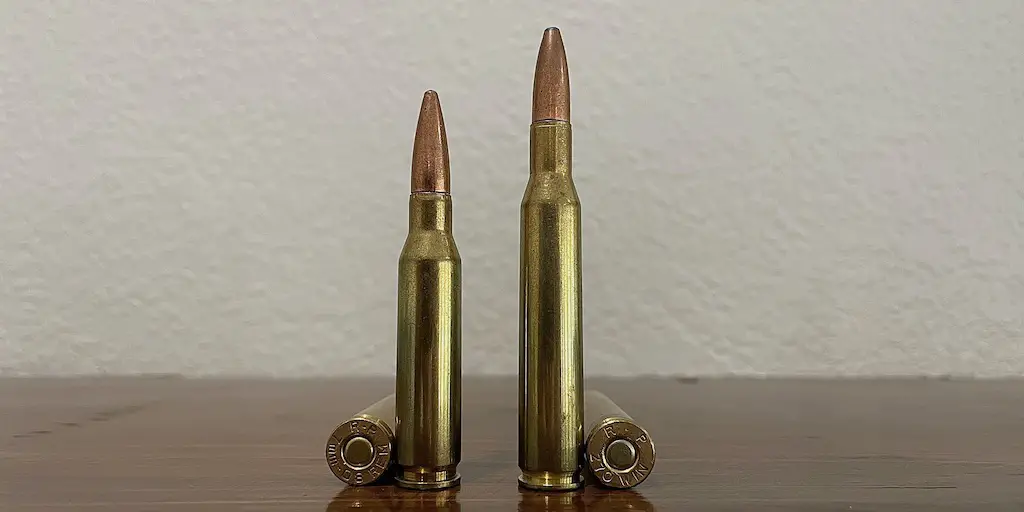
Bullet size and bullet weight are other important differences between the 7mm-08 vs 270 Winchester. The .270 Winchester uses .277″ diameter bullets while the 7mm-08 Remington uses larger .284″ bullets.
The vast majority of 270 factory loads shoot bullets in the 130-160 grain range, with 130gr and 150gr grain bullets easily being the most popular.
On the other hand, the 7mm-08 Remington cartridge most often uses bullet weights in the 120-160 grain range, with 120 grain, 140 grain, and 150 grain bullets being the most common.
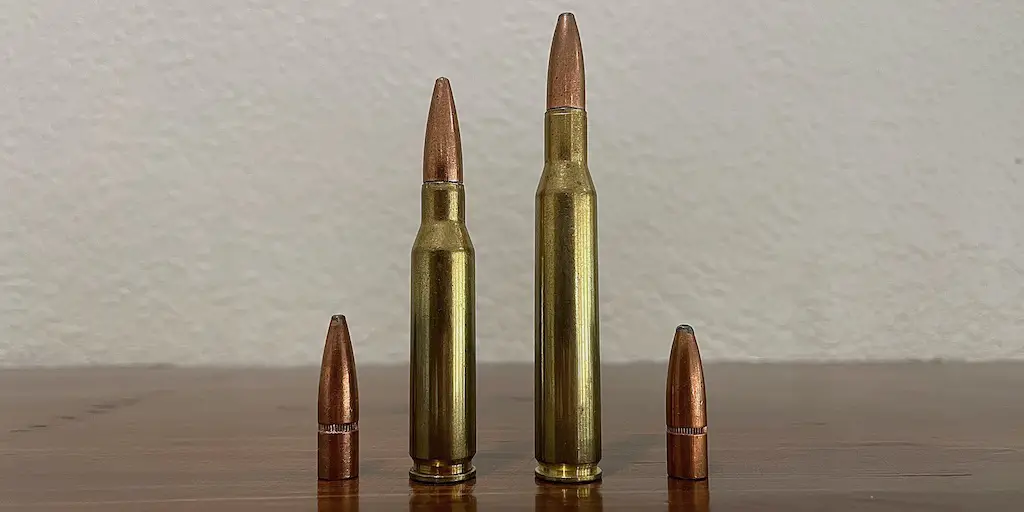
The 270 Winchester is also loaded to a higher SAAMI maximum average pressure of 65,000psi vs just 61,000psi for the 7mm-08 Remington
Note: while the powder capacity figures listed below do give a good indication of the differences between the two cartridges, exact case capacities vary slightly according to the brand of brass used.
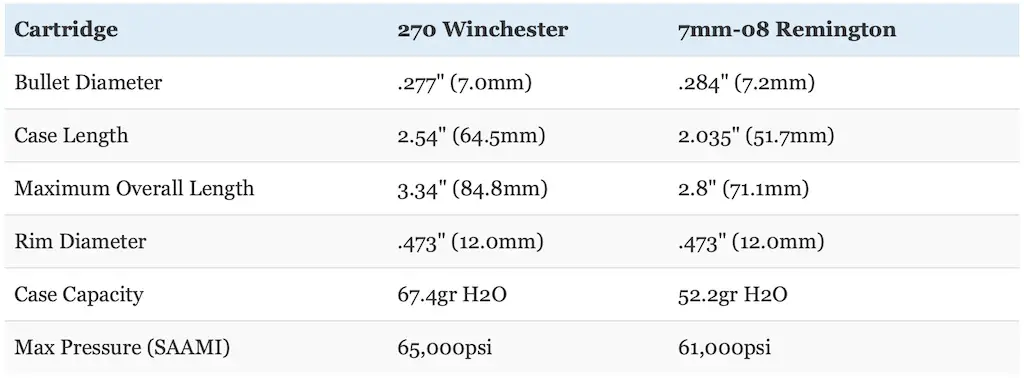
7mm-08 vs 270 Ballistics
The differences in the external dimensions of these cartridges also translate into some interesting differences in their ballistic performance. This is illustrated in the table below comparing Hornady Precision Hunter, Swift High Grade, and Winchester Deer Season XP factory ammunition.
The 270 Winchester loads use 130gr Extreme Point (.450 BC), 145gr ELD-X (.536 BC), and 150gr A-Frame (.444 BC) bullets.
Specifically, the 7mm-08 Remington loads use 140gr Extreme Point (.484 BC), 150gr ELD-X (.574 BC), and 160gr A-Frame (.450 BC) bullets.
Notice that the various bullets used in those 7mm-08 Remington loads all have a higher BC than those used in the comparable 270 Winchester loads.
The Winchester loads use light for caliber deer hunting bullets, the Hornady loads use heavier for caliber and exceptionally aerodynamic bullets with a very high BC, and the Swift loads use the heaviest commonly available bullets available for each cartridge in factory loads.
All six loads used a 200 yard zero.
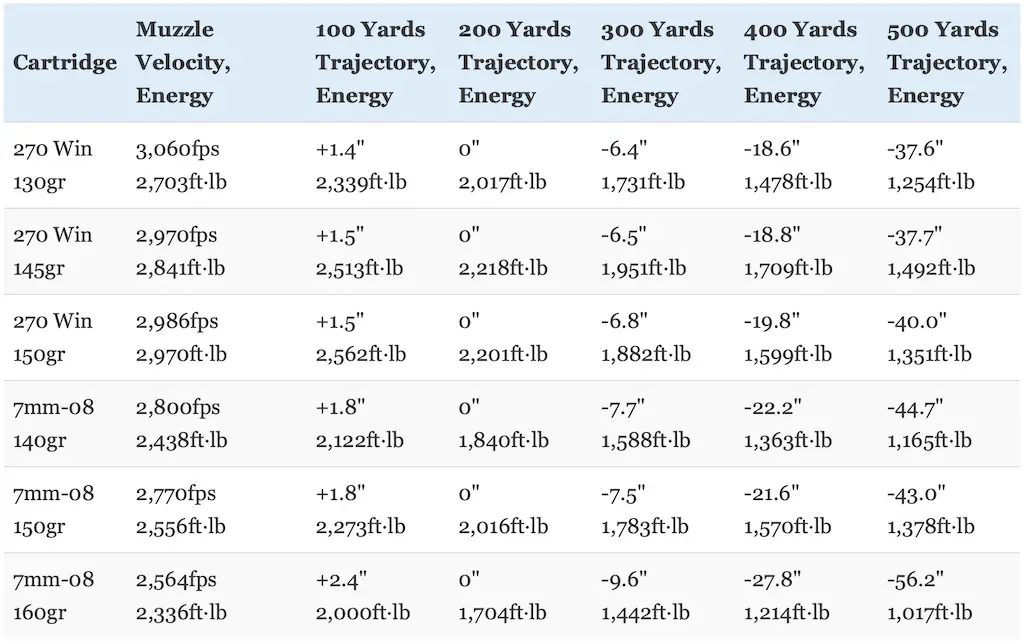
As you can see, the 270 Winchester is a flatter shooting cartridge than the 7mm-08. This is due to the higher muzzle velocity of all the 270 loads compared and the various 270 loads here are 170-497fps faster than the 7mm-08 loads above.
This translates into a noticeably flatter trajectory for the 270 Winchester with the 7mm-08 having 3-18.6″ more bullet drop at 500 yards. The differences are smaller at shorter range, but the 270 really starts to pull away around 400 yards.
At the same time, the 270 Winchester has a slight edge over the 7mm-08 in terms of kinetic energy.
The difference here is smaller than is the case with the 270 vs the 243 Winchester, but it’s an advantage nonetheless.
The 270 Winchester starts out with 6-27% more muzzle energy than the various 7mm-08 loads.
Just like with trajectory, the 270 Winchester has the advantage here because of the faster muzzle velocity of the cartridge. The velocity is squared when calculating kinetic energy, so small changes in velocity have a big effect in kinetic energy.
In particular, that 160gr loading for the 7mm-08 really struggles on paper because it’s so much slower than all the other loadings on this list. Similar to the case with the 308 Winchester shooting 180gr bullets, the 7mm-08 is operating near the upper edge of its capability with those really heavy 160gr bullets and it simply cannot push them very fast.
While that’s still a good loading for use on really big game (like elk and moose) at close range, the cartridge has sub-par performance on paper, especially as range increases.
Moving on from that 160gr load, since the 7mm-08 cartridge uses a more aerodynamic bullet than comparable 270 Winchester loads, that edge in kinetic energy shrinks and even flips in favor of the 7mm-08 as range increases in certain cases.
For instance, the 150gr ELD-X load for the 7mm-08 actually surpasses the 130gr XP around 200 yards and the 150gr A-Frame just shy of 400 yards. The 145gr ELD-X from the 270 still has about 8% more kinetic energy at 500 yards, but the cartridges are basically neck and neck for those particular loads.
All the loads in this comparison maintain at least 1,000 ft-lbs of energy out past 500 yards.
The 140gr and 150gr 7mm-08 loads maintain at least 1,500 ft-lbs of kinetic energy out to 300 yards (and past 400 yards for the 150gr ELD-X). However, the 160gr loading dips below 1,500ft-lbs of energy shy of 300 yards.
Likewise, the 145gr and 150gr 270 Winchester loads still carry 1,500ft-lbs of kinetic energy out past 400 yards.
So, the big takeaways so far are that the 270 Winchester has a flatter trajectory, but the 270 Winchester has a small edge in terms of kinetic energy at shorter range and is surpassed by very high BC 7mm-08 loadings as range increases.
The chart below compares how much a 10 mile per hour crosswind impacts those same 27o Winchester and 7mm-08 loads out to 500 yards.
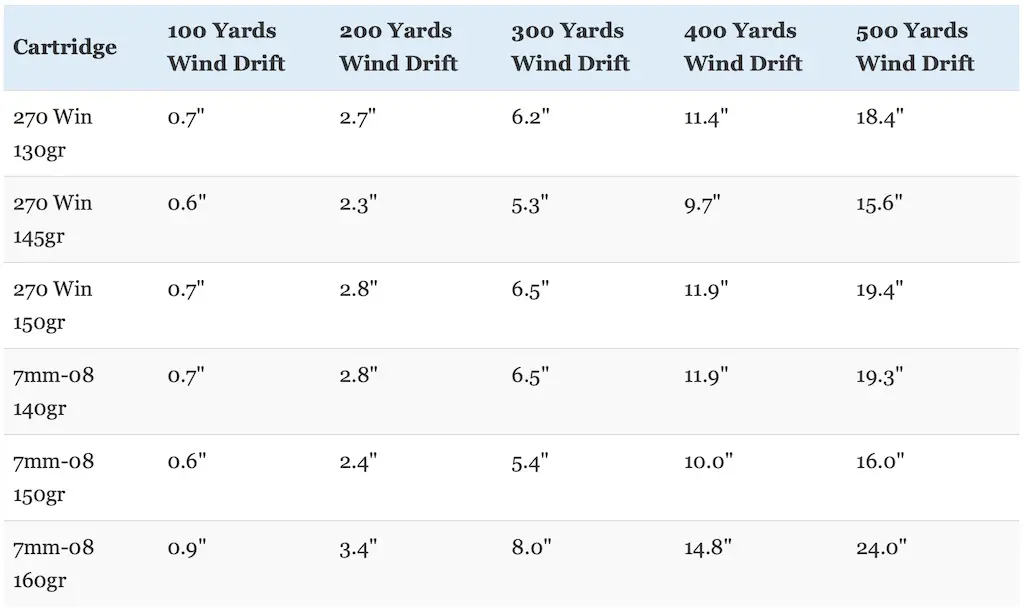
There’s quite a bit of overlap here, but the 270 Winchester seems to have a small edge overall.
While the 270 Winchester has a small edge in the trajectory department because it has a slightly faster muzzle velocity, this advantage is partially erased by the higher BC bullets used by the 7mm-08.
Indeed, the 130gr and 140gr Deer Season XP loads have similar amounts of wind deflection. The same goes for the 145gr and 150gr Precision Hunter loads. The gap is bigger with the Swift loads though.
The 270 Winchester has the advantage in each case though. That said, the 150gr ELD-X load from the 7mm-08 outperforms all the 270 loads except for the 145gr ELD-X load once again because it has such a high BC.
However, the limitations of the 7mm-08 (when compared to other 7mm cartridges like the 280 Remington, 280 Ackley Improved, 7 mm Rem Mag, etc) in terms of an inability to either use REALLY high BC bullets (like the 162gr ELD-X) and/or obtain really high muzzle velocities, do hamstring the 7mm-08 here to a certain degree.
With all that said, the differences between the 7mm-08 and 270 Winchester are definitely smaller at shorter range. The 270 still has less wind deflection at 100-300 yards, but the it’s not nearly as large of a contrast.
Now let’s talk about recoil.
The table below compares the recoil produced by handloads that approximate the performance of the Hornady factory loads above firing 145gr and 150gr ELD-X bullets for the 270 Winchester and 7mm-08 Remington respectively when fired from identical 7 pound rifles.

Felt recoil will vary from shooter to shooter and rifle to rifle, but free recoil energy is still a useful way to compare cartridges.
As you can see, the 7mm-08 has about 20% less recoil than the 270 Winchester.
All things considered, most hunters should be able to handle recoil from the 270 Winchester without too much trouble. The efficient little 7mm-08 just has even less recoil though.
So, the 7mm-08 has an advantage in this respect, especially for smaller or recoil shy hunters.
Don’t underestimate the impact that recoil has on the ability of a person to shoot accurately either.
Some people do handle recoil better than others, but all other things being equal, they will absolutely shoot more accurately with a milder recoiling cartridge.
What about 7mm-08 vs 270 accuracy?
The 7mm-08 is definitely capable of outstanding accuracy (often sub-MOA) in the right hands and when used in a quality rifle. The mild recoil of the cartridge also helps in that regard.
At shorter range, the cartridges are very evenly matched.
The 7mm-08 might has a small advantage due to the fact that the mild recoil of the cartridge no doubt helps hunters place their shots in the right spot to a greater extent than the 270 Winchester.
The situation changes a little bit when shooting at long distances though.
While the 270 Winchester isn’t exactly well suited for using exceptionally high BC bullets, neither is the 7mm-08 (though the 7mm-08 does have an edge there).
Even so, the much higher velocities that can be obtained with the 270 Winchester give that cartridge an edge at longer range where battling environmental conditions (like resistance to wind drift in particular) becomes more important.
That’s not to say that the 7mm-08 isn’t accurate or that there aren’t a bunch of good quality bullets available for it. It’s just that the overall design of the 270 Winchester gives that cartridge an (admittedly small) edge over the 7mm-08 in potential accuracy at extended range.
Additionally, there are a couple of other factors that are also worth discussing.
First, the 7mm-08 Remington uses larger diameter bullets than the 270 Winchester.
Specifically, the larger diameter .284″/7 mm bullets used by the cartridge have about 5% more frontal surface area (also known as cross sectional area) than the .277″ bullets used by the 270 Winchester (.0633 vs .0603 square inches). All other things being equal, a bigger bullet will make a bigger hole, cause more tissue damage, and result in more blood loss.
This is a small advantage in favor of the 7mm-08, especially on bigger game.
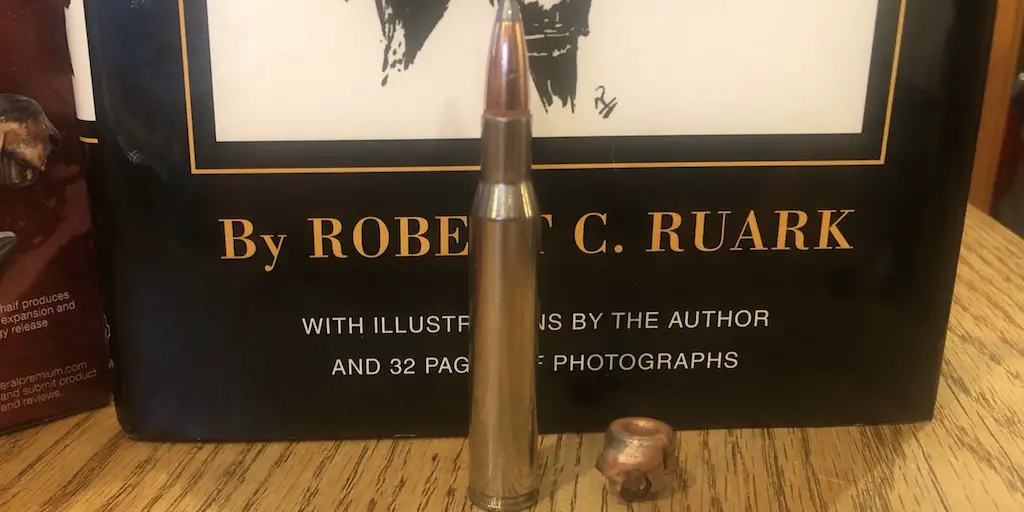
In fact, those larger diameter bullets can somewhat offset the kinetic energy advantage the 270 has in some cases (or enhance the advantage of the 7mm-08 in other cases). This can be helpful when hunting big game, especially deer or even potentially larger game.
At the same time, the 7mm-08 also has a small edge over the 270 Winchester in bullet sectional density.
Sectional density (SD) is a measure of the ratio of the diameter of a projectile to its mass.
All other things equal, a heavier bullet of a given caliber will be longer and therefore have a higher sectional density and consequently penetrate deeper than projectiles with a lower mass and sectional density.
As an example, 130 grain, 140 grain, and 150 grain .277″ bullets have sectional densities of .242, .261 and .279 respectively.
Compare that to 120 grain, 140 grain, 150 grain, and 160 grain .284″ bullets which have sectional densities of .213, .248, .266, and .283 respectively.
This is something of a mixed bag on the face of things.
The heaviest 160gr 7mm bullets outclass the heaviest .270 bullets, the 270 has the edge with stuff in the 140-150gr range.
The differences are small across the board, but when comparing the most popular bullet weights for each cartridge (a 140gr bullet from the 7mm-08 and a 130gr bullet from the 270), the 7mm-08 has a tiny edge.
The same is true with the really heavy stuff.
This leaves us in an interesting situation: the 270 Winchester is a more powerful cartridge in many respects, but the 7mm-08 tends to really punch above its weight.
Neither are a super heavy hitter on the level of cartridges like the 7mm Rem Mag, the 300 Win Mag, the 28 Nosler, the 300 PRC, or even the 30-06, but both are really solid middleweight cartridges.
7mm-08 vs 270 Barrel Life
Neither cartridge is really known as a terrible barrel burner. In fact, the 7mm-08 Remington is known for being a very efficient cartridge.
For that reason, the higher velocity and smaller bore 270 Winchester will probably have a shorter barrel life than the 7mm-08 Remington.
Exact barrel life for each cartridge depends on a number of factors like the quality of the barrel, the exact ammunition used, etc.
The good news for hunters is that typical barrel life for even the 270 Winchester is more than enough to last for many years of hunting with no issues. Exactly when the barrel is unusable depends on the rifle as well as the hunter in question and what sort of performance they expect from their rifle.
Those who want extremely tight groups for long range shooting are probably going to want to change their barrel out sooner than those with slightly lower standards.
All other things being equal, the 7mm-08 will probably have a longer barrel life than the 270 Winchester, but the difference is probably not big enough for the average hunter to worry about unless they are putting a really large number of rounds downrange.
So where do we stand with each cartridge?
7mm-08 vs 270 Winchester
The 7mm-08 fires a larger diameter, often heavier, and usually more aerodynamic bullet at a slower velocity than the 270. The 270 usually has a flatter trajectory, but more recoil. The cartridges have similar energy retention and wind deflection, but the 270 usually edges the 7mm-08 in both areas.
270 vs 7mm-08 Ammo
Both the 270 and 7mm-08 cartridges are extremely popular among hunters and shooters all over the world. Indeed, both (though certainly the 270) are also likely in the Top 10 most popular centerfire rifle cartridges in the United States. While the 7mm-08 is fairly popular itself, the 270 Winchester easily the most widely used of the two.
The big ammunition manufacturers like Barnes, Browning, Federal Premium, Hornady, Nosler, Remington, Sierra, Swift, and Winchester all produce a large variety of quality 7mm-08 and 270 factory ammunition suitable for hunting most species of big game. In each case, there is normally a good selection of bullet types and weights for each cartridge suitable for big game hunting.
Both cartridges are offered in most of the really popular hunting ammo lines: Barnes VOR-TX, Federal Power Shok, Hornady Precision Hunter, Nosler Trophy Grade, Remington Core Lokt, and Winchester Super X (just to name a few).
There are some isolated cases where one cartridge is available in a certain ammo line, but the other isn’t. This reflects both the performance characteristics and the common uses of each cartridge.
For instance, the 270 Winchester is available in the Barnes VOR-TX Long Range line while the 7mm-08 is not. Likewise, the 7mm-08 Remington is available in the Hornady Custom Lite line while the 270 is not.
While it’s often very easy to find a variety of ammo for both cartridges during normal times, ammo is usually a little easier to find and there will be a larger selection to choose from for the 270 Winchester. In general, prices are similar for both, but 270 Winchester ammo is often a little less expensive.
During the 2020-2022 ammo shortage, the difference between the two cartridges has become even more apparent and (at least where I live and shop) 270 Winchester ammo is usually easier to find and sometimes more reasonably priced than ammo for the 7mm-08.
Ammo availability is also usually decent online and the bigger retailers typically have a good selection of quality factory ammo for both cartridges as well (but the 270 Winchester will likely still be easier to find, even online).
Bottom line: the average hunter will likely have easier access to ammo for the 270 Winchester than the 7mm-08.
BUY SOME EXCELLENT 270 AMMO HERE
BUY SOME GREAT 7mm-08 AMMO HERE
If you’d like to learn more about some of the various hunting ammunition choices for the 270 Winchester and 7mm-08 Remington, read these articles:
Best 270 Ammo For Hunting Deer, Hogs, And Other Big Game
Best 7mm-08 Ammo For Hunting Deer, Hogs, And Other Big Game
Handloaders will appreciate the fact that reloading components for both cartridges are widely available and there’s an excellent variety of bullet choices for each cartridge. So, you should not have any trouble working up a good custom load for either one if you like to handload.
The 270 Winchester uses the same .277″ bullet size as the 6.8 Remington SPC, 270 Winchester Short Magnum, 270 Weatherby Magnum, 27 Nosler, and the 6.8 Western.
The 7mm-08 Remington uses the same 7mm/.284″ bullet size as other 7mm cartridges like the 7mm Mauser, 280 Remington, 280 Ackley Improved, 7mm Remington Magnum and 28 Nosler.
270 vs 7mm-08 Rifles
Once again, the 270 Winchester is usually more common than the 7mm-08 Remington when it comes to rifle selection. However, there’s a good selection of rifles chambered in both cartridges.
Both cartridges are really common in bolt-action rifles. In fact, just about every really popular bolt-action hunting rifle in current production is available in both cartridges.
For instance, both the 270 Winchester and 7mm-08 Remington are available in several different versions of the Remington Model 700 and Winchester Model 70. The same goes for the Browning X-Bolt, Christensen Arms Mesa, Kimber Hunter, Mossberg Patriot, Ruger American, Ruger Hawkeye, Savage Axis, Savage 110, Tikka T3x, Weatherby Vanguard, and Winchester XPR.
While both rifles are most common in bolt-action rifles, they’re also available in a few lever-action and semi-automatic models as well.
Both cartridges are available from Browning in their Browning Automatic Rifles (BAR) and Browning Lever Action Rifles (BLR).
Additionally, while it’s not a very common offering, the 7mm-08 is also an option for those who prefer modern sporting rifles. In particular, while the cartridge is too long for use in an AR-15, it’s available in larger frame AR-10 platforms from companies like Wilson Combat.
So, you can probably find a good deer rifle available in either cartridge regardless of the action type you prefer.
Additionally, barrel lengths do vary for both cartridges depending on the manufacturer and exact model.
The 270 Winchester is most common in rifles with 22″ barrels, but it’s also not unusual to see that cartridge in rifles with longer 24″ barrels.
On the other hand, the 7mm-08 is also common with a 22″ barrel length. The characteristics of the efficient 7mm-08 cartridge also make it well suited for more compact rifles with shorter barrels. So, 20″, 18″ and even 16″ long barrels are not unusual with that cartridge.
Since it’s a short action cartridge, 7mm-08 rifles also often have a slightly shorter bolt throw and a shorter overall length.
For instance, the Winchester Model 70 Super Grade is available in both 270 Winchester and 7mm-08 Remington.
The 270 Winchester version has a 24″ long barrel, is 44.75″ long overall, and weighs 8 pounds 4 ounces.
The 7mm-08 version of that rifle has a 22″ long barrel, is 42.25″ long overall, and weighs 7 pounds 12 ounces.
As another example, Ruger manufactures their Ruger American Compact rifle in 7mm-08, but only offers the 270 Winchester in their standard American rifle.
That particular 7mm-08 rifle has an 18″ long barrel and a 36.75″ overall length compared to the 22″ long barrel and 42.5″ overall length of the 270 rifle.
Like I said, details vary depending on the exact manufacturer and rifle model in question. However, all things considered, rifles chambered in 270 Winchester tend to be slightly longer, heavier, and more unwieldy than rifles chambered in 7mm-08 Remington.
Having a shorter and lighter rifle is more important on some hunts than on others. So, just keep that in mind.
BUY A GREAT 270 RIFLE HERE
BUY AN EXCELLENT 7mm-08 RIFLE HERE
If you’d like to learn more about some of the various hunting rifle choices for the 270 Winchester cartridge, read this article:
Best 270 Winchester Hunting Rifles
7mm-08 vs 270 Winchester: Which Is Right For You?
Do you primarily hunt medium sized game like whitetail deer and feral hogs at ranges within 200 yards? Both are outstanding deer hunting cartridges and will work on great deer sized game with good shot placement.
Indeed, a 7mm-08 shooting a 140 grain bullet and a 270 Winchester shooting a 130 grain bullet are both classic loads used by untold numbers of deer hunters over the years.
Go with the 270 Winchester if you want something a little more versatile or if you want cheaper and/or easier to find ammo and rifles.
Additionally, if you’re going to be hunting in the tight confines of a deer stand or in thick brush, remember what I just mentioned about the size difference with 7mm-08 vs 270 rifles. That extra couple of inches in overall length of a rifle can be a real headache to deal with when trying to quickly and quietly maneuver for a shot. So, definitely consider the 7mm-08 if you’d prefer a more compact rifle.
Are you looking for the cartridge better suited for long range hunting for game like mule deer or pronghorn antelope in open country where you might need to take a shot at longer ranges? The 270 Winchester has a flatter trajectory and more resistance to wind deflection, but the efficient 7mm-08 performs surprisingly well in this area, especially with a really good high BC bullet (like the 150gr Hornady ELD-X).
I’d give the 270 Winchester the edge here overall, but there are definitely specific cases where the 7mm-08 can be a better choice.
Do you want a hunting cartridge that’s well suited for black bear, caribou, moose, elk, eland, kudu, or red stag hunting? Honestly, this is another area where it may be a wash between the two cartridges. Depending on the exact load, the 270 Winchester often carries more kinetic energy downrange. However, the 7mm-08 uses larger diameter bullets and performs surprisingly well in this area too.
Loaded with a quality 150-160gr Partition or A-Frame, or a 139-140gr lead free bullet (like the Nosler E-Tip or Hornady CX), the 7mm-08 is absolutely deadly on really big game at reasonable ranges.
For instance, Randy Newburg cleanly killed a bull moose with a single shot from his 7mm-08 a couple years ago.
While not often counted among the real “heavy hitters”, the 270 Winchester can also be darn effective in this role when using heavy for caliber, controlled expansion bullets (like a 150gr Nosler Partition).
After all, lots of hunters have killed untold numbers of those animals with a .270 over the years. If anything, the .270 Winchester is even more effective on really large game (elk hunting in particular) now than it was even 20 years ago because hunters have access to much better quality bullets these days.
For instance, the 150gr Nosler Partition below really did a number on a big kudu bull in South Africa. The same hunter also used that particular rifle and loading to achieve one shot kills on blue wildebeest, zebra, and impala.
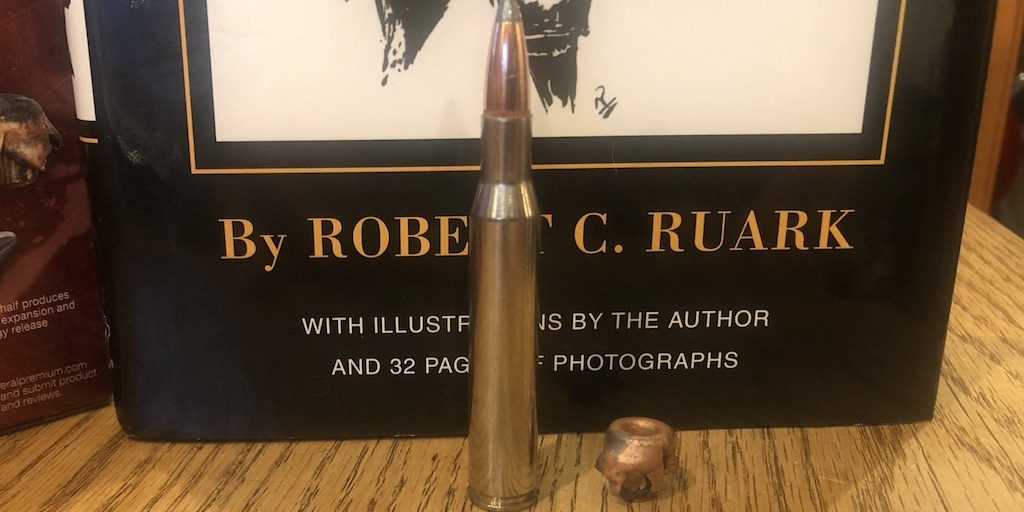
Are you sensitive to recoil and in need of a serious low recoil cartridge? Neither is a terrible recoiling cartridge, but the 7mm-08 Remington has a big advantage over the 270 Winchester here.
Indeed, the 7mm-08 Remington is an especially great choice as a centerfire rifle cartridge for a newer and/or recoil shy hunter. That cartridge is very “shootable” in a rifle that fits the hunter well, has a good recoil pad, and is equipped with either a suppressor or a muzzle brake.
Hornady also offers the cartridge in their Custom Lite line, which is a great reduced power option for deer hunting that will cleanly take a deer, but have even less recoil than the already mild recoiling 7mm-08.
Are you looking for a great cartridge for sheep, mountain goat, or tahr hunting where you need an effective cartridge with manageable recoil in a lightweight and easy to carry rifle? Both will certainly work to one degree or another. Thanks to Jack O’Connor, the .270 Winchester is considered a classic sheep hunting cartridge if there ever was one.
I’d give the 270 Winchester the edge here since it has the flattest trajectory, most resistance to wind drift, and the most retained energy at extended range when using ideal bullets. However, the 7mm-08 isn’t a bad choice here either because it’s such an efficient cartridge that really punches above its weight.
As I’ve stated before: the 7mm-08 Remington and 270 Winchester are both solid rifle cartridges. However, while there’s a lot of overlap in their performance and ideal uses, there are some significant differences between them (7mm-08 vs 270) in certain respects and each cartridge is better suited to specific situations than the other.
Carefully evaluate your needs as a hunter based upon the circumstances you foresee using the cartridge in, get a good hunting rifle chambered in the cartridge you select, learn to shoot it well, use quality bullets, and it should serve you well afield.
NEXT: BEST 6.5 CREEDMOOR AMMO FOR HUNTING ELK, DEER, & OTHER BIG GAME
NEXT: BEST GIFTS FOR HUNTERS
Enjoy this article comparing the 270 Winchester and 7mm-08 Remington cartridges? Please share it with your friends on Facebook and Twitter.
The Lyman 50th Edition (p197-198 and p205-206) and Hornady 10th Edition (p351-355 and p364-369) reloading manuals were used as references for the history of the 7mm-08 vs 270 cartridges. I obtained the data used to compare the trajectory of the cartridges from Hornady (here and here), Nosler (here and here), and Winchester (here and here). Data used to calculate recoil was obtained from the Hornady 10th reloading manual (p354 & p367). Case capacity information for the 7mm-08 Remington and 270 Winchester were obtained from Chuck Hawks (here). Maximum pressure and data to compare cartridge sizes for the 7mm-08 Remington and 270 Winchester were obtained from SAAMI (p24 and p28). I used ShootersCalculator.com to compare trajectory and recoil for the cartridges.
Make sure you subscribe to The Big Game Hunting Podcast and follow The Big Game Hunting Blog on Facebook, Instagram, Twitter, and YouTube.


